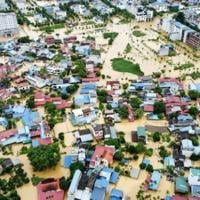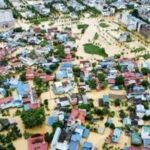Millions of people across Southeast Asia struggled Thursday with flooded homes, power cuts, and wrecked infrastructure after Typhoon Yagi swept through the region, as the death toll passed 200.
In worst-hit Vietnam, the number of fatalities rose to 197, with nine confirmed dead in northern Thailand — where one district is experiencing its worst floods in 80 years.
Yagi made landfall in Vietnam over the weekend, bringing heavy rain that has affected a large portion of northern Vietnam, Laos, Thailand, and Myanmar, leading to deadly landslides and widespread river flooding.
One farmer shared with AFP that his entire 1,800 square meter peach blossom plantation was submerged, resulting in the destruction of all 400 of his trees.
“It will be incredibly challenging for me to recover from this loss — I estimate I will lose up to $40,000 this season,” said the farmer, known only as Tu.
“I am unsure of what steps to take next; I am just waiting for the water levels to drop.”
The United Nations children’s agency (UNICEF) reported that over 140,000 homes across 26 provinces in Vietnam have been damaged by the typhoon.
UNICEF has supplied water to homes, health centers, and schools in the hardest-hit areas and plans to send medical and sanitation supplies to the Vietnamese government in the days ahead.
– Communications severed –
The flooding has devastated more than 250,000 hectares of crops and a large number of livestock, as stated by Vietnam’s agriculture ministry, with farmland surrounding Hanoi being hit particularly hard.
In some parts of the Vietnamese capital, commuters walked to work through knee-deep floodwaters, although officials reported that river levels in the city are gradually decreasing after reaching a 20-year high on Wednesday.
Thousands of people have been forced to evacuate their homes, while others are grappling with power outages. In one severely affected district on the outskirts of Hanoi, over 15,000 individuals have been impacted by the floods.
Vietnamese state media documented a landslide in mountainous Lao Cai province that claimed the lives of seven people, with 11 others still missing. The incident occurred on Tuesday, but details only emerged later because communication with the area had been cut off, officials told state media.
This adds to a separate landslide in the same province that destroyed an entire village of 37 houses, resulting in at least 42 confirmed deaths and 53 people still unaccounted for.
Fifteen bodies have been recovered in Cao Bang province following a landslide on Monday that pushed a bus, along with several cars and motorbikes, into a stream, according to state media reports on Thursday.
– Luang Prabang alert –
The Mekong River Commission, which oversees the vital waterway, issued a flood warning on Thursday for the historic Laotian city of Luang Prabang.
The Mekong River is anticipated to reach flood levels in Luang Prabang, a UNESCO world heritage site, on Thursday, according to the commission’s bulletin.
In Thailand, the death toll has climbed to nine, as reported by the Department of Disaster Prevention and Mitigation, including six individuals who perished in landslides in Chiang Mai province.
All flights to the airport in Chiang Rai, located approximately 145 kilometers (90 miles) northeast of Chiang Mai, have been halted, according to aviation authorities.
In Mae Sai district, situated on the border with Myanmar, the worst floods in 80 years are being experienced, declared Suttipong Juljarern, a senior official from the interior ministry, in a statement.
Prime Minister Paetongtarn Shinawatra has instructed supplies to be dispatched to the affected regions and mobilized the military to provide boats, helicopters, and other transportation to support relief efforts.
Buddhist temples, as well as hotels and resorts, have opened their doors to shelter nearly 1,000 people who have been displaced from their homes, the government disclosed.
In Myanmar, flooding is most severe around the low-lying capital Naypyidaw controlled by the junta, while the town of Taungoo is also under threat from rising river levels.
The state-run newspaper, The Global New Light of Myanmar, reported that train services on the main line between Yangon and Mandalay have been suspended due to flooding in certain sections.
Southeast Asia is regularly battered by heavy monsoon rains, but human-induced climate change is leading to more severe weather patterns, which can increase the likelihood of destructive floods.
According to a study published in July, climate change is causing typhoons to develop closer to the coastline, intensify more rapidly, and linger longer over land.
burs-pdw/rsc





